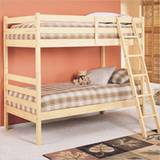
Bunk bed injuries account for numerous visits to the doctor. However, there are two things that can be done to minimize the risk of bunk bed injuries: enforcing safe behavior and checking for bunk bed construction standards.
Bunk Bed Safe Behavior:
-
Children under the age of six should not be left unattended in a room with bunk beds, or be allowed to use them. The greatest instances of bunk bed-related injuries are from falls, and more than half of them occur in children under the age of five.
-
Only one person should be allowed on the top bunk at a time and there should be absolutely no horseplay on or under beds.
-
Do not let children hang any items, for instance, hooks, belts, jump ropes, etc. to any part of the bunk bed as it could pose a strangulation hazard.
-
Make sure to reinforce bunk bed safety rules regularly. Go over the rules whenever your child has a fiend sleep over. Never assume that they may be familiar with your rules, and remember they may need reminding even if they have slept over before.
Safe Bunk Bed Construction:
-
There should be guardrails on the top bunk and the single opening for entering and exiting should be no more than 15 inches.
-
The rails on the top bunk should extend at least 5 inches above the top surface of the mattress. Check the rails to make sure they are sturdy.
-
Make sure that the mattress is the proper size for the unit, as stated by the manufacturer. Never use a smaller or larger size as it could fall and hurt your child.
-
Have your child always use a sturdy ladder to enter and leave the top bunk. The ladder should be free of toys, clothes or other clutter.
-
According to new guidelines published by ASTM International in 2007, bunk beds manufactured after March 2008 may not have any type of "finial" or corner post on the headboard or footboard. This is to help prevent accidental strangulation caused by something the child is wearing or carrying catching on the bed as the child exits the upper bunk.
Additional Considerations:
-
Never position a bunk bed under or near a ceiling fan or ceiling light fixture.
-
Do not place the bunk bed against a window.
-
Make sure that there is room for your child to sit up without bumping his head on the ceiling.





